HOME SCIENCE
PAPER – III
Note : This paper contains seventy five (75) objective type questions of two (2) marks each. All questions are compulsory.
1. Protein urea is a major symptom in the following diseases :
(1) Typhoid
(2) Renal disease
(3) Atherosclerosis
(4) Ulcers
2. Following is not a method of dietary survey :
(1) Food frequency questionnaire
(2) 24 hours recall
(3) BMI
(4) Food weighment
3. A change that occurs during cereal cookery
(1) Winterization
(2) Homogenization
(3) Retrogradation
(4) Coagulation
4. Which method is used for recipe adjustment ?
(1) Mark up
(2) Percentage
(3) Prime
(4) BARS
5. Which of the following fibers is used for foundation garments ?
(1) Spandex
(2) Kevlar
(3) Carbon
(4) Glass
6. Which of the following stitch classes represents lock stitch ?
(1) 100
(2) 200
(3) 300
(4) 400
7. The name of the famous book written by F.W. Taylor is
(1) The Philosophy of Management
(2) Management : Tasks, Responsibilities, Practice
(3) General and Industrial Management
(4) The principles of scientific management
8. Food Safety and Standards Act was implemented in the year
(1) 2008
(2) 2006
(3) 2000
(4) 2010
9. A treatment which has no effect and is administered to a “control group” in experimental research in place of a treatment whose effects are being studied is called
(1) Controls
(2) Attrition
(3) Chorion
(4) Placebo
10. ________ is an unwarranted feeling that others are trying to harm you.
(1) Phobia
(2) Trauma
(3) Paranoia
(4) Mania
11. Individual reflection, contemplation and meditation are the chief functions of the following type of communication
(1) Intrapersonal communication
(2) Interpersonal communication
(3) Dyadic communication
(4) Intracultural communication
12. Which of the following states in India has the least number of women per 1,000 men, as per the census of the year 2011 ?
(1) Kerala
(2) Gujarat
(3) Tamil Nadu
(4) Haryana
13. The following oils are rich source of Mono Unsaturated Fatty Acids (MUFA) :
I. Coconut oil
II. Mustard oil
III. Olive oil
IV. Safflower oil
Codes :
(1) I and II
(2) I and III
(3) II and III
(4) III and IV
14. Following are the disorders due to Iodine deficiency :
I. Mental Retardation
II. Cretinism
III. Tetany
IV. Hypothyroidism
V. Dermatitis
Codes :
(1) I, II and V
(2) I, II and IV
(3) II, III and IV
(4) II, IV and V
15. Following signs and symptoms are seen in patient with end stage renal disease :
I. Oliguria
II. Hyperglycemia
III. Azotemia
IV. Oedema
V. Hyperbilirubinemia
VI. Osteodystrophy
Codes :
(1) I, II, IV, and VI
(2) I, II, III and VI
(3) I, III, IV and VI
(4) I, III, V and VI
16. Following are the properties of egg :
I. Binding
II. Browning
III. Emulsifying
IV. Fermenting
V. Thickening
VI. Leavening
Codes :
(1) II, III, IV, VI
(2) I, II, V, VI
(3) I, III, V, VI
(4) III, IV, V, VI
17. Following toxins are present in pulses :
I. Luteins
II. Typsin inhibitor
III. Hemicellulose
IV. Lathyrogens
V. Goitrogens
Codes :
(1) II, IV, V
(2) I, II, III
(3) II, III, IV
(4) III, V, I
18. TQM has the following sub-system :
I. Human resource development
II. Customer focus
III. Zero budgeting
IV. Strategic approach to operations
V. Total employee participation
VI. Modular equipment
Codes :
(1) I, III, IV, VI
(2) I, II, IV, V
(3) II, III, V, VI
(4) III, IV, V, VI
19. Which of the following are components of a dye ?
I. Auxochrome
II. Chromophore
III. Pigment
IV. Ink
Codes :
(1) I, III
(2) II, IV
(3) I, II
(4) II, III
20. Which of the following are styles of printing ?
I. Direct
II. Resist
III. Discharge
IV. Transfer
Codes :
(1) II, III, IV
(2) III, IV, I
(3) I, II, III
(4) I, II, IV
21. Which of the following are types of Phulkari ?
I. Chope
II. Til patra
III. Saloo
IV. Bayton
V. Durjani
Codes :
(1) I, II, III
(2) II, III, IV
(3) III, IV, I
(4) IV, I, II
22. Which of the following are the tools in time-management ?
I. Work curve
II. Rest period
III. Posture
IV. Peak load
Codes :
(1) I, II, III
(2) I, II, IV
(3) II, III, IV
(4) I, III, IV
23. Which of the following motivators are listed in Herzberg’s theory of motivation ?
I. Challenging work
II. Physiological need
III. Growth in job
IV. Recognition
Codes :
(1) I, II, III
(2) II, III, IV
(3) I, III, IV
(4) I, II, IV
24. Which of the following are included in the list of voluntary consumer organizations ?
I. PIL
II. CGSI
III. VOICE
IV. CUTS
Codes :
(1) I, II, IV
(2) I, II, III
(3) III, IV, I
(4) II, III, IV
25. Advantages of parenthood mentioned by contemporary couples include :
I. Gives meaning to life
II. Someone to carry ones name
III. Loss of freedom
IV. Exchange of affection
Codes :
(1) I, II, III
(2) II, III, IV
(3) I, II, IV
(4) I, III, IV
26. Depressed people experience major distortion of logical thought which include :
I. Arbitrary inference
II. Magnification
III. Elation
IV. Overgeneralizations
Codes :
(1) I, II, III
(2) I, III, IV
(3) II, III, IV
(4) I, II, IV
27. The verbal subtest of WAIS-R includes the following :
I. Comprehension
II. Memory span
III. Arithmetic
IV. Picture assembly
Codes :
(1) I, II, III
(2) I, III, IV
(3) II, III, IV
(4) I, II, IV
28. The selection of a channel for communication is based on :
I. Availability
II. Organisational Hierarchy
III. Cost
IV. Frequency of use
Codes :
(1) I, II, III
(2) II, III, IV
(3) I, III, IV
(4) I, II, IV
29. The National Policy for empowerment of women focuses on the following aspects of women’s lives :
I. Advancement
II. Development
III. Empowerment
IV. Entertainment
Codes :
(1) I, II, III
(2) II, III, IV
(3) I, III, IV
(4) I, II, IV
30. For an entrepreneur, the target market means :
I. A group of customers a venture reaches by accident.
II. All consumers who will choose to purchase the venture’s product.
III. A chain of discount stores.
IV. A specific group of potential customers towards which a venture aims its marketing plan.
Codes :
(1) I and II
(2) II and III
(3) II and IV
(4) I and IV
31. Assertion (A) : The Colostrum secreted in the first few days of lactation helps build up immunity in the infant.
Reason (R) : Colostrum is rich in gamma-globulins and vitamin A.
Codes :
(1) (A) is correct and (R) is incorrect.
(2) (A) is incorrect and (R) is correct.
(3) Both (A) and (R) are correct.
(4) Both (A) and (R) are incorrect.
32. Assertion (A) : Dietary interventions with probiotics are recommended in diarrhoea patients.
Reason (R) : Foods high in probiotics alter the gut microflora.
Codes :
(1) Both (A) and (R) are correct.
(2) (A) is correct and (R) is incorrect.
(3) (A) is incorrect and (R) is correct.
(4) Both (A) and (R) are incorrect.
33. Assertion (A) : Diet induced thermogenesis is lower in diets that contain very high amounts of fats.
Reason (R) : The process of digestion, absorption and metabolism of fats utilizes more energy compared to carbohydrates.
Codes :
(1) Both (A) and (R) are correct.
(2) (A) is incorrect and (R) is correct.
(3) (A) is correct and (R) is incorrect.
(4) Both (A) and (R) are incorrect.
34. Assertion (A) : Mayonnaise is considered as a permanent emulsion.
Reason (R) : Sugar, salt, acids are used as stabilizer in mayonnaise.
Codes :
(1) Both (A) and (R) are correct.
(2) Both (A) and (R) are incorrect.
(3) (A) is correct but (R) is incorrect.
(4) (A) is incorrect but (R) is correct.
35. Assertion (A) : Break even analysis and calculation of Break even point is an important part of purchase, layout design and labour recruitment.
Reason (R) : It is based on systems of record and reports providing database.
Codes :
(1) (A) and (R) are incorrect.
(2) (A) is incorrect, but (R) is correct.
(3) (A) and (R) are correct.
(4) (A) is correct but (R) is incorrect.
36. Assertion (A) : Acid dyes are suitable for wool and silk.
Reason (R) : Acid dyes form ionic bonds with the amino groups found in wool and silk.
Codes :
(1) (A) is correct but (R) is incorrect.
(2) (A) is incorrect but (R) is correct.
(3) Both (A) and (R) are incorrect.
(4) Both (A) and (R) are correct.
37. Assertion (A) : The most suitable method of printing with disperse dyes is transfer printing.
Reason (R) : Disperse dyes sublime when heated to high temperature.
Codes :
(1) Both (A) and (R) are incorrect.
(2) Both (A) and (R) are correct.
(3) (A) is correct but (R) is incorrect.
(4) (A) is incorrect but (R) is correct.
38. Assertion (A) : Threadless bonding and welding offers a tangible alternative solution to the sewing of microfiber textiles.
Reason (R) : This technology has the ability to produce narrow lap seams which are less bulky.
Codes :
(1) Both (A) and (R) are incorrect.
(2) Both (A) and (R) are correct.
(3) (A) is correct but (R) is incorrect.
(4) (A) is incorrect but (R) is correct.
39. Assertion (A) : Anthropometrics is a system of identification based upon measurement of selected portions of human frame.
Reason (R) : Anthropometric deals with measurement of dimensions and proportions of human body.
Codes :
(1) Both (A) and (R) are correct.
(2) Both (A) and (R) are incorrect.
(3) (A) is incorrect but (R) is correct.
(4) (A) is correct but (R) is incorrect.
40. Assertion (A) : Organisation is an important tool for the managerial performance.
Reason (R) : Lack of organisation gives rise to many defects in its structure.
Codes :
(1) Both (A) and (R) are correct.
(2) (A) is correct but (R) is incorrect.
(3) (A) is incorrect but (R) is correct.
(4) Both (A) and (R) are incorrect.
41. Assertion (A) : Children who are institutionalized and deprived of love and affection in the early years have negative outcomes as adults.
Reason (R) : Early deprivation leads to attachment disorders and lack of trust development in later life.
Codes :
(1) Both (A) and (R) are correct.
(2) Both (A) and (R) are incorrect.
(3) (A) is correct but (R) is incorrect.
(4) (A) is incorrect but (R) is correct.
42. Assertion (A) : Child budgeting must begin at the very level of Panchayats, the very basic unit of democratic functioning.
Reason (R) : This will logically result in decentralization in implementation and monitoring of programmes for children.
Codes :
(1) Both (A) and (R) are correct.
(2) Both (A) and (R) are incorrect.
(3) (A) is correct but (R) is incorrect.
(4) (A) is incorrect but (R) is correct.
43. Assertion (A) : To identify strategic parameters for participatory development, it is important to specify, who the stakeholders are.
Reason (R) : Stakeholders are individual persons, groups or institutions with vested interest in the intervention.
Codes :
(1) (A) is correct and (R) is incorrect.
(2) (A) is incorrect and (R) is correct.
(3) Both (A) and (R) are correct.
(4) Both (A) and (R) are incorrect.
44. Assertion (A) : Theories based on research done on the lives of women have evidenced in equality of the sexes.
Reason (R) : The concepts of Gender, Patriarchy and sex roles are implicated in the inequality.
Codes :
(1) (A) is correct and (R) is incorrect.
(2) (A) is incorrect and (R) is correct.
(3) Both (A) and (R) are correct.
(4) Both (A) and (R) are incorrect.
45. Assertion (A) : Extension workers have to be sensitive to the cultural changes taking place in the communities, they work with.
Reason (R) : Outsiders do not realize that villages ever change because often there is little outward change as compared with urban areas.
Codes :
(1) (A) is correct, (R) is incorrect.
(2) (A) is incorrect and (R) is correct.
(3) Both (A) and (R) are correct.
(4) Both (A) and (R) are incorrect.
46. Arrange in correct sequence the stages in development of non-alcoholic liver disease :
I. Jaundice
II. Oedema/ascites
III. Gastro intestinal disturbances such as nausea and vomiting
IV. Oesophageal Varices
V. Gastro intestinal bleeding
Codes :
(1) III, I, II, V, IV
(2) I, III, II, V, IV
(3) III, I, II, IV, V
(4) II, I, III, IV, V
47. Arrange in correct sequence the progression of the development of eye symptoms due to Vitamin A deficiency.
I. Conjunctival xerosis
II. Corneal xerosis
III. Night blindness
IV. Corneal scar
V. Keratomalacia
Codes :
(1) III, I, II, V, IV
(2) III, I, II, IV, V
(3) I, III, II, V, IV
(4) III, II, I, IV, V
48. Arrange in correct sequence the steps in the pathway of Carbohydrate metabolism :
I. Glucose-6-PO4
II. Triose Phosphate
III. Fructose 1-6-Biphosphate
IV. Glycogen
V. Phosphoenol Pyruvate
VI. Pyruvate
VII. Glucose-1-PO4
Codes :
(1) IV, VII, I, III, II, V, VI
(2) IV, I, VII, II, III, V, VI
(3) IV, VII, I, II, V, III, VI
(4) VII, I, IV, II, III, VI, V
49. Arrange in the right sequence the processes of chocolate manufacture :
I. Mixing
II. Tempering
III. Milling
IV. Roasting
V. Conching
VI. Addition of other ingredients
VII. Molding
Code
(1) III, I, II, VI, VII, V, IV
(2) I, IV, III, II, V, VII, VI
(3) IV, III, VI, I, V, II, VII
(4) VI, I, II, IV, V, VII, III
50. Arrange the steps involved in bulk purchasing of food in the correct sequence :
I. Estimate quantities
II. Identify amounts to be purchased
III. Determine standards
IV. Market research for vendors
V. Identify needs
VI. Develop purchase order
VII. Select and negotiate with vendors
Codes :
(1) V, III, I, II, VI, IV, VII
(2) I, II, VII, VI, IV, V, III
(3) II, III, IV, V, I, VII, VI
(4) IV, I, III, II, VI, VII, V
51. Give the correct sequence of cut order planning in a garment industry :
I. Determining volume, size ratios for marker making and spreading.
II. Examining incoming orders and piece goods availability.
III. Developing instructions for optimum fabric utilization.
IV. Determining whether there are available markers or new markers have to be made.
V. Releasing orders for marker making, spreading and cutting.
Codes :
(1) I, II, III, IV, V
(2) III, II, I, V, IV
(3) IV, III, II, I, V
(4) II, I, IV, III, V
52. Give the correct sequence of making Kanthas :
I. Collection of coloured and while threads from the border.
II. Forming a lay of fabrics and stitching it together.
III. Washing of fabric with gram flour.
IV. Compartmentalization of the surface
V. Tearing off the coloured borders and making the fabrics uniform in size.
VI. Filling in between spaces.
VII. Filling the compartments with the required design.
Codes :
(1) I, III, II, IV, VI, VII, V
(2) V, VI, IV, III, II, I, VII
(3) III, V, I, IV, VII, VI, II
(4) III, V, I, II, IV, VII, VI
53. Arrange the following steps of planning in a sequence :
I. Preparation of derivative plans.
II. Determination of objectives
III. The use of strategy
IV. Providing follow up to the proposed course of action.
V. Establishment of planning premises
VI. Timing and sequence of operations
VII. Selection of the operating plan
Codes :
(1) I, VII, VI, III, IV, II, V
(2) II, V, VII, I, VI, III, IV
(3) III, IV, VII, II, I, V, VI
(4) IV, III, I, II, VI, V, VII
54. Arrange the following steps in making a budget in a sequence :
I. Estimate the cost of desired items.
II. List down the commodities and services needed by the family.
III. Check plans to see that they have a reasonable chance of success.
IV. Estimate total expected income.
V. Bring expected income and expenditure into balance.
Codes :
(1) II, I, IV, V, III
(2) III, IV, V, I, II
(3) IV, III, I, II, V
(4) I, V, II, III, IV
55. Arrange the following steps in making time-plans in a sequence :
I. Determine time sequence.
II. List all the items to be included grouping under flexible and inflexible activities.
III. Bring total estimated time needed and total available time into harmony.
IV. Write out plan.
V. Set out as accurate on estimate for each task as is obtainable.
Codes :
(1) III, IV, II, I, V
(2) V, I, III, II, IV
(3) II, V, III, I, IV
(4) IV, III, V, II, I
56. Arrange in sequence the processes that need to be undertaken to rehabilitate a child who is abandoned
I. Initiate restoration process
II. File on FIR
III. Produce the child before CWC
IV. Admit to children home
V. When child legally free place in adoption
Codes :
(1) II, IV, III, I, V
(2) I, II, III, IV, V
(3) II, IV, III, V, I
(4) II, IV, I, III, V
57. Arrange in order of development of motor skills
I. Rolls from side to back
II. Head holding
III. Stands alone
IV. Walks on tip toes
V. Climbs upstairs with help
Codes :
(1) I, II, III, V, IV
(2) I, II, III, IV, V
(3) II, I, III, IV, V
(4) II, I, III, V, IV
58. Arrange in order of enactment of legislations from earliest to latest :
I. The Child Labour Act
II. The Immoral Traffic (Prevention) Act
III. Prevention of Child Sexual Offences Act
IV. The Juvenile Justice (Care & Protection) of Children Act
Codes :
(1) III, I, II, IV
(2) II, IV, III, I
(3) I, II, III, IV
(4) II, I, IV, III
59. Arrange the elements of the communication process as per the Shannon’s and Weaver’s model :
I. Destination
II. Transmitter
III. Signal
IV. Receiver
V. Source
Codes :
(1) V, III, II, IV, I
(2) V, II, IV, III, I
(3) V, II, III, IV, I
(4) V, IV, III, II, I
60. Arrange the following learning experiences as per the Edgar’s Dale’s cone of experience from the base of the pyramid upwards :
I. Dramatised experiences
II. Field Trips
III. Exhibits
IV. Direct purposeful experiences
V. Demonstrations
VI. Contrived experiences
Codes :
(1) IV, III, VI, V, II, I
(2) IV, V, VI, III, II, I
(3) IV, VI, I, V, II, III
(4) IV, III, II, I, V, VI
61. Match the physiological group given in List – I with RDA of energy (ICMR, 2010) given in List – II :


62. Match the terms given in List – I with their explanation given in List – II :

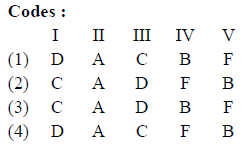
63. Match the organisms, that cause food spoilage given in List – I with their mode of transmission via food in List – II


64. Match the terms given in List – I with Foods in List – II :
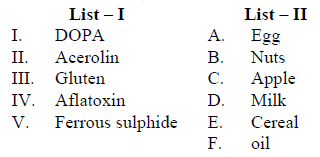

65. Match the Acronym in List – I with terms in List – II :


66. Match the finishes given in List – I with their purpose given in List – II


67. Match the Kasuti stitches given in List – I with their description given in List – II


68. Match the items in List – I with the items in List – II
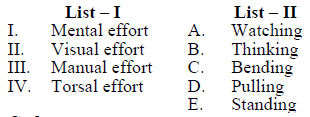

69. Match the items given in List – I with the items given in List – II :

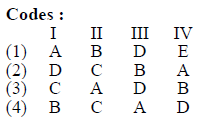
70. Match the items in List – I with List – II

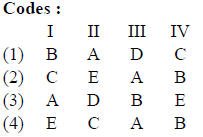
71. Match the theorists in List – I with the theories in List – II
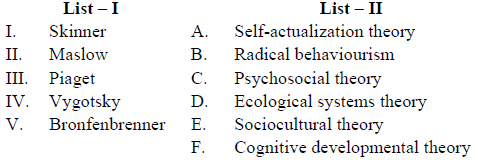
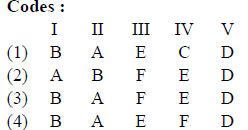
72. Match the disorder illness in List – I with the associated problem in List – II
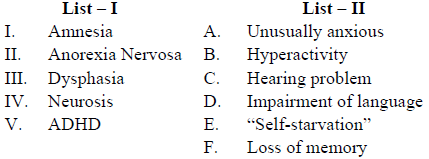
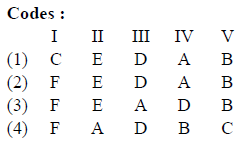
73. Match fine motor skills in List – I with age of development in List – II


74. Match the desirable qualities of the elements of communication given in List – I with the name of the element given in List – II
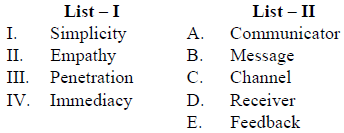

75. Match the concepts given in List – I with their proponents given in List – II

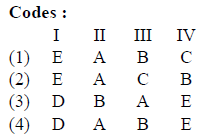
Latest Govt Job & Exam Updates: